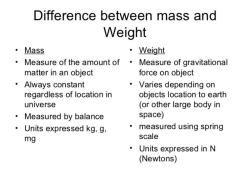Are weight and density the same thing?
No, weight and density are not the same thing. They are distinct physical properties and concepts that are used to describe different aspects of objects and materials.
Weight:
- Weight is a measure of the force of gravity acting on an object. It is typically measured in units such as pounds (lb) or newtons (N). An object's weight can vary depending on its location because gravity varies with location. For example, your weight on Earth's surface is different from your weight on the Moon's surface or in deep space.
Density:
- Density, on the other hand, is a measure of how much mass is contained in a given volume. It is expressed in units like kilograms per cubic meter (kg/m³) or grams per cubic centimeter (g/cm³). Density is a property that remains constant regardless of an object's location in the universe. It describes how tightly packed the particles or molecules in a substance are. For example, lead is denser than wood because it has more mass in the same volume.
To distinguish between weight and density, consider that weight depends on the gravitational force acting on an object, while density describes how much matter is packed into a specific volume. An object will have the same density regardless of its location in the universe, but its weight will vary based on the strength of the gravitational field where it's located.
The Distinction Between Weight and Density
Weight and density are two different physical properties. Weight is a measure of the force of gravity acting on an object, while density is a measure of the amount of matter in a given volume.
Weight is measured in units of force, such as newtons (N) or pounds (lb). Density is measured in units of mass per unit volume, such as kilograms per cubic meter (kg/m³) or grams per cubic centimeter (g/cm³).
Weight as a Measure of Mass and Gravity
Weight is a measure of the mass of an object and the strength of the gravitational field in which it is located. The more mass an object has, the greater its weight will be. The stronger the gravitational field, the greater the weight of the object will be.
For example, an object on Earth will weigh less on the Moon than it does on Earth because the Moon has a weaker gravitational field. An object on Jupiter will weigh more than it does on Earth because Jupiter has a stronger gravitational field.
Density as a Property of Matter
Density is a measure of the amount of matter in a given volume. It is calculated by dividing the mass of an object by its volume.
D = m/V
where:
- D is density
- m is mass
- V is volume
The density of a substance is a constant property of that substance. It is not affected by the gravitational field.
For example, water has a density of 1 g/cm³ regardless of where it is located. Iron has a density of 7.874 g/cm³ regardless of where it is located.
Applications of Weight and Density in Science and Engineering
Weight and density are important properties in science and engineering. They are used in a variety of applications, including:
- Weight: Weight is used in the design of vehicles, aircraft, spacecraft, and other structures. It is also used in the design of bridges and other structures that must support heavy loads.
- Density: Density is used in a variety of applications, including:
- Separating materials: Density can be used to separate materials of different densities. For example, gold can be separated from sand by using a process called panning. In panning, the gold and sand are mixed with water and then swirled around in a pan. The gold, which has a higher density than the sand, will sink to the bottom of the pan. The sand, which has a lower density than the gold, will float to the top of the pan.
- Determining the purity of a substance: The density of a substance can be used to determine its purity. For example, the density of pure gold is 19.32 g/cm³. If a sample of gold has a density lower than 19.32 g/cm³, then it is not pure gold.
- Calculating buoyancy force: The density of a fluid can be used to calculate the buoyancy force acting on an object submerged in the fluid. Buoyancy force is the upward force that is exerted on an object submerged in a fluid. The buoyancy force is equal to the weight of the fluid displaced by the object.
How to Calculate Weight and Density
To calculate the weight of an object, you can use the following equation:
W = mg
where:
- W is weight
- m is mass
- g is the acceleration due to gravity (9.81 m/s² on Earth)
To calculate the density of an object, you can use the following equation:
D = m/V
where:
- D is density
- m is mass
- V is volume
For example, to calculate the weight of a 10 kg object on Earth, you would use the following equation:
W = mg = 10 kg * 9.81 m/s² = 98.1 N
To calculate the density of a 10 kg object with a volume of 1 m³, you would use the following equation:
D = m/V = 10 kg / 1 m³ = 10 kg/m³













